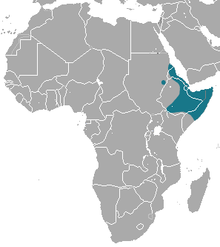Abyssinian hare
| Abyssinian hare | ||||||||||||
|---|---|---|---|---|---|---|---|---|---|---|---|---|

Abyssinian hare ( Lepus habessinicus ) |
||||||||||||
| Systematics | ||||||||||||
|
||||||||||||
| Scientific name | ||||||||||||
| Lepus habessinicus | ||||||||||||
| Hemprich & Ehrenberg , 1832 |
The Abyssinian or Abyssinian hare ( Lepus habessinicus ) is a species of mammal belonging to the genus of the real hare within the hare-like species . Its distribution area is limited to a part of East Africa in the Horn of Africa in the area of the eponymous former empire Abyssinia .
features
The Abyssinian Hare is small to medium-sized with a head-torso length of 40 to 55 centimeters and a weight of about 2 kilograms. The back color is cinnamon brown with black or black mottled markings. The tail is black on top and white on the underside. The ears are not particularly long and have a slight black border. Compared to other hares of the genus Lepus , the species has an isolated interparietal bone in its skull, which is fused to the parietal bone in the other species .
distribution
The distribution area of the Abyssinian Hare is limited to a part of East Africa in the Horn of Africa . It includes Somalia with the exception of the south, eastern Ethiopia , Djibouti , Eritrea and a small portion of Sudan and possibly also Kenya . It is expanding into regions affected by overgrazing . The altitude distribution ranges from sea level to around 2000 or even 2500 meters.
Way of life
The Abyssinian Hare lives in open grasslands, grass steppes and savannahs up to desert-like areas in which bushes are present as protective vegetation. In these areas it prevails against the kaphase ( L. capensis ), while regions with denser vegetation of other species such as the bush hare ( L. saxatilis ), the Ethiopian hare ( L. fagani ) or the Ethiopian highland hare ( L. starcki ) are populated. The Abyssinian Hare is probably nocturnal.
Systematics
The species status of the Abyssinian hare is controversial and it is considered by some scientists as a subspecies of the Kaphasen ( Lepus capensis ); due to the sympatric occurrence with the kaphase, however, an independence is assumed.
Apart from the nominate form, no subspecies are distinguished within the species .
Hazard and protection
The species is classified as “least concern” by the International Union for Conservation of Nature and Natural Resources (IUCN) due to its large distribution area and high population numbers. There are no known major threats to the species population, but it is assumed that the range and populations will increase in favor of this species due to overgrazing and the associated habitat changes.
literature
- Joseph A. Chapman, John EC Flux (Eds.): Rabbits, Hares and Pikas. Status Survey and Conservation Action Plan. International Union for Conservation of Nature and Natural Resources (IUCN), Gland 1990, ISBN 2-8317-0019-1 , p. 80, (PDF; 11.3 MB).
Web links
- Lepus habessinicus inthe IUCN 2012 Red List of Threatened Species . Listed by: Andrew T. Smith , CH Johnston, CH, 2008. Retrieved November 18, 2012.
supporting documents
- ↑ a b c Joseph A. Chapman, John EC Flux (Ed.): Rabbits, Hares and Pikas. Status Survey and Conservation Action Plan. International Union for Conservation of Nature and Natural Resources (IUCN), Gland 1990, ISBN 2-8317-0019-1 , p. 80, (PDF; 11.3 MB).
- ↑ a b c d e Lepus habessinicus in the Red List of Threatened Species of the IUCN 2012.2. Listed by: Andrew T. Smith , CH Johnston, CH, 2008. Retrieved November 18, 2012.
- ↑ a b Lepus (? Uncertain) habessinicus . In: Don E. Wilson , DeeAnn M. Reeder (Eds.): Mammal Species of the World. A taxonomic and geographic Reference. 2 volumes. 3. Edition. Johns Hopkins University Press, Baltimore MD 2005, ISBN 0-8018-8221-4 .
